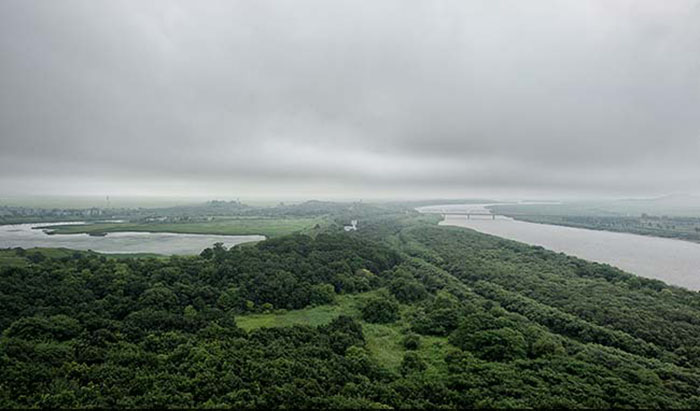Asian giant covets sea access held by North Korea

Now, China is hoping to triumph over decades of false starts and finally secure access to the sea, enabling it to ship goods produced here to destinations elsewhere in Asia - and farther afield - instead of sending them by train to ports to the south.
Authorities are pumping money into infrastructure projects as part of President Xi Jinping`s plan to build a new Silk Road trading route and to make this area, which incorporates the Yanbian autonomous prefecture with its large ethnic Korean population, relevant again.
South Korea wants a part of the action, too. It is eyeing the area as a kind of off-site Korean unification project, with businesses preparing for when North Korea opens up - or for when it fails, although they are careful not to talk in such a pointed way.
"There are lots of companies just perched here, just waiting for North Korea to collapse," said one foreign resident in the area, speaking on the condition of anonymity so as not to jeopardize his work.
The biggest South Korean presence here - although its officials swear they`re here for the trading hub, not positioning themselves for the demise of North Korea - is Hunchun Posco Hyundai International Logistics. A joint venture between two South Korean corporate behemoths, it has built a big distribution center on the outskirts of Hunchun, a Chinese city half an hour`s drive from the point where the three countries converge.
"Of course we see the potential of this area," Yeon Jei-sung, the company`s president, said in an interview in his office. "The three countries meet here, and that in itself can be a core place for trade."
Such a pronouncement, however, is predicated on one crucial factor: the development of Rajin port. And Rajin port is in North Korea.
"We should have taken it while we had the chance," said a local real estate developer, referring to the Korean War, when China came to North Korea`s rescue. He spoke on the condition of anonymity to avoid annoying local Koreans.
While North Korea is promoting the area - Rajin and the neighboring city of Sonbong are together known as Rason - as a special economic zone, previous efforts at opening have not gone far.
Over the years, this area has been described as "the next Rotterdam." In the early 1990s, the U.N. Development Program spearheaded an ambitious project called the Greater Tumen Initiative, named after the river that runs through the region. The project went nowhere.
This is not an obvious place for the world`s next great logistics hub. This is where some of the most forgotten parts of three countries converge: the Far East of Russia, where 6 million people live in an area the size of Europe; the depopulating northeast of China, which managed to miss out on the country`s boom of recent decades; and the northern reaches of North Korea, a difficult place to survive and where the "hostile" classes have long been sent to languish.
North Korea established Rason as a free-trade zone in 1991, modeled on zones that had powered the export-led explosion of growth in China. But nothing much happened until 2010, when the regulations governing the area were loosened and the Kim regime began some tentative experimentation - for example, allowing residents to buy apartments and foreigners to enter more easily.
This time, the project might stand more of a chance, said Adam Cathcart, a lecturer in Chinese history at the University of Leeds in England. "It`s been 25 years since they started talking about this, and it`s gone in fits and starts, but mostly not moving," he said. "There is a certain critical mass now."
The huge amount of money that China is spending on infrastructure in the region could prove to be a game-changer, Cathcart said.
China has built a $7 billion, 225-mile-long high-speed railway line from Changchun, the capital of Jilin province, to Hunchun. It is set to open this month. The Russian news agency Interfax reported in May that provincial authorities had suggested extending the line all the way to Vladivostok, Russia. The plan is that the rail line will eventually connect with North Korea.
For now, China is building a bridge across the Tumen River at the Quanhe border crossing with North Korea - it is clearly visible from look-out points in the area - and China also is building a road to Rajin.
This area of northeastern China was a center for heavy industry, particularly mining and automotive manufacturing, during the first half of the 20th century, especially during the Japanese occupation. But it suffered under the market-oriented economic reforms that Chinese leader Deng Xiaoping initiated in 1978 and more recently as large numbers of the ethnic Korean population have left for better opportunities in South Korea.
Xi has a plan to stimulate the growth heavy industry in northeast China, part of his "Belt and Road" initiative, through infrastructure such as the rail project, aimed at making it easier for people to come here.
The area is also crucial for South Korean President Park Geun-hye and her "Eurasia Initiative," which would link South Korea to Europe by rail but for the not-inconsiderable physical obstacle that is North Korea.
With that in mind, Posco, a South Korean steel maker, has teamed with Hyundai to build the logistics center here in Hunchun, a city of 220,000. It has three storage units acting as a staging post for goods on their way in and out of the region, including seafood - clams, squid and octopus - from North Korea. The logistics center also handles agricultural goods, timber and auto parts from China, and expansions are planned depending on demand.
A Washington Post reporter saw several trucks with Rason license plates entering China at the Quanhe border crossing near Hunchun. But being able to ship Chinese products out in the other direction, through Rajin port, would provide a huge boost to the region, proponents say.
Today, sending a container from Hunchun by train through China and then by sea to South Korea costs about $2,000. Exporting it directly from the port of Rajin would halve that cost, said Yeon, the Posco president.
"Rajin is going to open up - maybe in three to five years," he said. "It`s imminent."
But Yeon has never been to Rajin, partly because of a South Korean government requirement citizens to get official permission to enter North Korea.
Despite the obstacles to gaining access to North Korea, South Korean companies, hungry for new markets and eyeing the 26 million potential consumers in the North, still view the area as a new opportunity.
Recent reports, including one by the South`s Korea Development Institute, have suggested that South Korean companies could contract Chinese firms to run factories in border cities including Hunchun and hire North Korean workers. North Koreans already work in factories run by South Korean companies at a small inter-Korean industrial park, but sanctions have limited the firms` ability to hire additional cheap labor from the North.
A recent poll from the South`s Korea Chamber of Commerce and Industry found that 87 percent of companies surveyed have or would have an interest in doing business in the North if unification were to occur.
There are many impediments to a breakthrough, not the least of which is North Korea and its irascibility.
"The problem is still Rason and getting to it," said Cathcart, who has written reports about the region. "The relationship between China and North Korea with regards to the use of Rason is still problematic. It`s not unfettered access."
South Korea`s Eurasia Initiative and its plans to link up with the Trans-Siberian and Trans-China railways depend on North Korea`s allowing the South`s trains to pass through the country. But Pyongyang in June blocked South Korea`s bid to join the organization that approves cross-border rail lines, a requirement in building a trans-Asian railway.
And China`s plans have been complicated by North Korea`s 2013 nuclear test, which resulted in new international sanctions, and by North Korean leader Kim Jong Un`s decision to execute his uncle, Jang Song Thaek, the main interlocutor in business deals between North Korea and China.
For its part, Russia has shown little interest in the area. A lonely looking Russian-built storage facility is visible from the Posco center, but locals say it has never been operational. And Russia`s Summa Group was supposed to be developing the port at Zarubino, also near this intersection, but has reportedly run out of money.
China has more reason than ever to develop this area, says Xuan Dongri, director of the Institute of Northeast Asian Studies at Yanbian University.
"China is pretty anxious about this," he said, adding that without North Korea`s cooperation to develop the region, China will be hampered in realizing its dream of greater prosperity.
"No matter what, this brother of ours is still very important," Xuan said. "And for China`s dealings in northeast Asia, North Korea is the biggest obstacle."















































